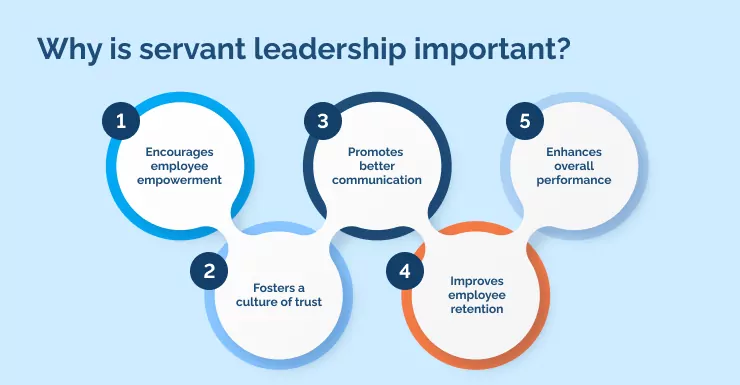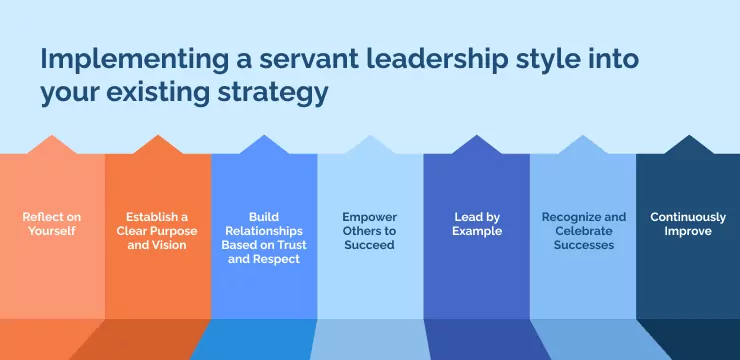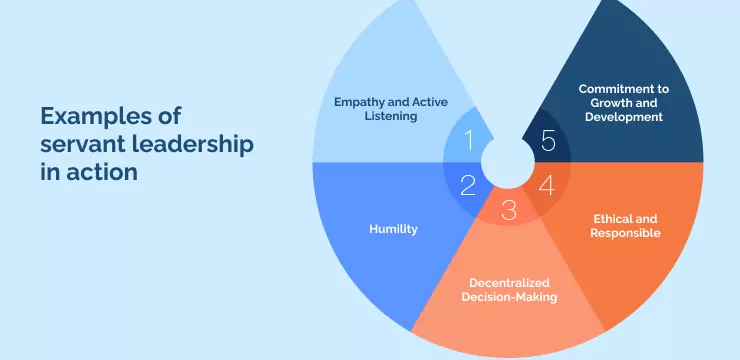
Servant leadership is a style of leadership that emphasizes the needs of the team and the health of the organization above the needs of the leader.
This approach empowers team members to achieve their goals and grow personally and professionally. Building an employee development strategy emphasizing servant leadership will enable you to prioritize their needs, build trust, provide support, and create a positive work environment.
A recent study conducted by Business Perspectives found that 82.5% of those under a servant leadership style reported a heightened level of job satisfaction and empowerment. But most businesses fail to implement a true servant leadership style.

This is most likely because many business owners and managers are still stuck in the traditional “command-and-control” style of change management. To truly implement a servant leadership style, you must first put the needs of your team members ahead of your own. This is difficult for many managers and business owners, as it requires extreme selflessness.
Once you have committed to serving your team members, ensure you provide them with the support and contextual guidance they need. This includes giving them clear expectations for their role, providing feedback, and a clear direction on their performance while creating a positive work environment where team members feel comfortable to ask questions and express ideas.
This article will explore how you can implement a servant leadership style in your business and its benefits for your team members. It will also provide some tips on successfully empowering your team with servant leadership in the context of a modern working environment.
What is servant leadership?
Servant leadership is a leadership philosophy that emphasizes the leader’s responsibility to prioritize the needs and development of others, such as employees or customers, above their own self-interest.
This approach aims to achieve personal and organizational goals by empowering and serving those under the leader’s authority rather than controlling them. Those who practice servant leadership create a supportive and collaborative work environment by listening empathetically to their team, developing the skills and abilities of their employees, and inspiring them to contribute to the organizational effectiveness goals.
By prioritizing the needs of others, servant leaders cultivate a culture of trust, respect, and growth within their organization.
Why is servant leadership important?

Servant leadership is becoming increasingly essential for effective leadership in today’s fast-paced business world. Here’s why:
1. Encourages employee empowerment
Servant leadership empowers employees to make decisions and take ownership of their work. Giving them a sense of autonomy and trust makes them more engaged and accountable for their actions, ultimately leading to higher job satisfaction and productivity.
2. Fosters a culture of trust
When leaders prioritize the needs of their team members, it fosters a culture of trust. They feel valued and respected, which creates an environment where people are more likely to share ideas, collaborate, and take risks.
3. Promotes better communication
Servant leaders should prioritize active listening and encourage open communication. Leaders can gain valuable insights and make informed decisions by creating an environment where employees feel comfortable sharing their thoughts and concerns.
4. Improves employee retention
Employees who feel valued and supported are likelier to stay with a company long-term. Servant leadership promotes a sense of community and a shared sense of purpose, which can help build loyalty and reduce turnover rates.
5. Enhances overall performance
Ultimately, servant leadership can lead to better overall performance for the organization. Leaders can create a more engaged and motivated workforce by fostering a culture of collaboration, trust, and empowerment.
Servant leadership Vs. traditional leadership
Servant leadership and traditional leadership are two distinct styles of leadership that have gained significant attention and debate in the business world.
While traditional leadership emphasizes authority, control, and decision-making power, servant leadership focuses on serving the needs of others and empowering them to achieve their goals. In this article, we will compare and contrast both styles of leadership.
Traditional leadership is a top-down approach where the leader has absolute control over decision-making. Leaders who adopt this style often prioritize their own interests and objectives above those of their subordinates. They rely on their position of power to give orders and expect compliance from their team members. This leadership style is effective in situations where quick decisions must be made or in highly structured environments such as military or law enforcement.
Servant leadership emphasizes putting the needs of others first and empowering them to reach their potential. Servant leaders act as facilitators, coaches, and mentors, helping their team members to develop their skills, knowledge, and abilities. This style of leadership requires high levels of empathy, emotional intelligence, and patience. Servant leaders are more likely to delegate responsibility and decision-making power to their team members, which creates a sense of ownership and motivation.
One of the key differences between servant leadership and traditional leadership is how they measure success. Traditional leaders may focus on achieving short-term goals, such as meeting sales targets or increasing profits.
In contrast, servant leaders prioritize the development and well-being of their team members over immediate results. They strive to create a positive and supportive environment where everyone can grow and thrive.
Implementing a servant leadership style into your existing strategy

Incorporating a servant leadership style into existing strategies and processes is crucial for fostering a culture of empathy, collaboration, and accountability. By prioritizing the needs of team members and empowering them to make decisions, servant leaders create a sense of ownership and commitment that drives productivity and innovation.
This approach helps build trust and loyalty within the organization, leading to long-term success and sustainable growth. We’ve outlined the following tips to help you implement a servant leadership style in existing processes:
Reflect on Yourself
Before incorporating servant leadership into your current strategy, you need to reflect on yourself as a leader. You must assess your strengths, weaknesses, and motivations in leading people. You need to identify areas to improve to become a more service-oriented leader. Self-reflection is an essential step in developing a servant leadership mindset.
Key Takeaway: Servant leadership is not just a way of leading; it’s a way of life. It requires humility, empathy, and a genuine desire to serve others. You may need to change your perspective on what leadership means to you to develop these qualities. Instead of focusing on power and authority, shift your focus to the needs of your team members.
Establish a Clear Purpose and Vision
A servant leader puts the needs of others first. Therefore, establishing a clear purpose and vision centered around serving others is critical. You must define and align your team’s goals and objectives with this vision. Communicate your concept clearly and regularly to your team so they understand the direction you are headed.
Key Takeaway: A clear purpose and vision will help your team members stay motivated and feel connected to their work. They will see how their contributions fit the bigger picture and understand how their work positively impacts others. A clear purpose and vision can also help build trust and respect between you and your team members.
Build Relationships Based on Trust and Respect
Strong relationships built on trust and respect are essential for servant leadership. You need to create an environment where everyone feels valued and respected. Get to know your team members individually, actively listen to their concerns, and show empathy when they share their challenges.
Key Takeaway: Building relationships based on trust and respect requires vulnerability. As a leader, you must be willing to admit your mistakes, ask for feedback, and create an atmosphere where everyone can speak their mind. When you establish an environment of trust and respect, your team will feel safe to share their ideas, opinions, and suggestions.
Empower Others to Succeed
A servant leader empowers team members to achieve their goals and develop their skills. You need to encourage your team to take ownership of their work and provide them with the tools and resources they need to be successful. This means delegating tasks, offering support, and providing clear expectations.
Key Takeaway: Empowering others is not just about giving them more responsibilities. It’s about trusting them to do their best work and supporting them along the way. As a leader, you need to be willing to step back and let your team members take the lead. Remember that empowering others means giving up control and trusting your team members’ abilities.
Lead by Example
As a servant leader, you must lead by example. Demonstrate the behaviors and values that you want to see in your team, and hold yourself accountable to the same standards. This means modeling the behavior you expect from your team members, such as honesty, integrity, and respect.
Key Takeaway: Leading by example means being transparent and authentic. If you make a mistake, admit it and take responsibility for it. If you’re going through a challenging time, share your experience with your team and show vulnerability. When you lead by example, you set the tone for your team members and create a culture of accountability.
Recognize and Celebrate Successes
Celebrating your team’s successes and recognizing their hard work and achievements is essential for boosting morale and motivation. Acknowledge the contributions of your team members and let them know their efforts are appreciated. This can be done through public recognition, rewards, or simply saying “thank you.”
Key Takeaway: Recognizing and celebrating successes can help your team members feel valued and motivated to continue working hard. It can also help build a culture of positivity and collaboration. When team members know their hard work is recognized and appreciated, they are more likely to feel invested in their work.
Continuously Improve
Servant leadership is an ongoing process. There is always room for improvement; as a leader, you must be committed to learning and growing. Continuously seek feedback from your team and look for ways to improve your leadership approach. Stay open-minded, adaptable, and committed to learning and growing as a leader.
Key Takeaway: Continuous improvement means changing your approach when something isn’t working. It means being open to new ideas and perspectives and being willing to adapt to the needs of your team members. When you continuously improve, you show your team members that you are invested in their success and committed to creating a positive work environment.
Examples of servant leadership in action

Every executive needs to have a clear understanding and awareness of the practical implementation of servant leadership through the following examples:
Empathy and Active Listening
A servant leader demonstrates empathy and listens actively to their team members. They put themselves in their team members’ shoes to understand their needs, concerns, and challenges.
They listen without judgment and show genuine interest in what each person says. Active listening involves asking clarifying questions, summarizing what the person said, and following up to ensure they understood correctly.
By actively listening and demonstrating empathy, servant leaders build trust with their team members, foster open communication, and create a support culture.
Humility
Servant leaders are humble and prioritize the needs of their team over their own. They acknowledge that their role is to serve their team and create an environment where everyone can succeed. They recognize and appreciate the skills and talents of their team members and encourage them to contribute to the team’s success.
Humility also involves admitting mistakes, seeking feedback, and being open to learning from others.
Decentralized Decision-Making
Servant leaders involve their team members in decision-making. They value the input and ideas of their team members and recognize that everyone’s perspective is valuable.
Decentralized decision-making involves delegating authority to team members, encouraging them to take ownership of their work, and empowering them to make decisions that impact their work.
The servant leader provides guidance and support while allowing team members to exercise their judgment and expertise.
Ethical and Responsible
Servant leaders take accountability for their actions and their team’s actions. They demonstrate ethical behavior and act with transparency and integrity. They communicate honestly with their team, even when the message is not easy to convey.
Moreover, they make sure that their team members act ethically and take prompt action if any ethical issues arise.
By modeling ethical behavior and being responsible, the servant leader creates a culture of trust and respect.
Commitment to Growth and Development
A servant leader is committed to developing the skills and abilities of their team members. They provide opportunities for learning and growth, such as training, coaching, and mentoring. They support their team members in setting goals and help them achieve those goals. The Servant leader also encourages their team members to take on new challenges and learn from their experiences.
By investing in the growth and development of their team members, the servant leader helps create a motivated and engaged workforce.
Becoming a “servant first” leader in 2023
Research from Sage demonstrates that leaders who listen attentively to their team members promote improved performance and job satisfaction.
Possessing empathy is essential for servant leaders to create an environment of trust, respect, and collaboration. Empathy enables leaders to put themselves in their team members’ shoes, understand their perspectives, and respond appropriately.
Servant leaders should model behavior that creates a positive culture. Research from NCBI shows that team members tend to emulate the behavior of their leaders. Thus, when leaders exhibit respectful, honest, hardworking, and approachable behavior, team members are likelier to display similar traits. This creates a virtuous cycle that reinforces positive behavior, leading to higher levels of engagement, motivation, and performance.
The modern servant-first leader serves their team by providing support, resources, and guidance. By doing so, they facilitate their team’s growth and development, making it more likely for team members to feel valued and supported.
WalkMe Team
WalkMe spearheaded the Digital Adoption Platform (DAP) for associations to use the maximum capacity of their advanced resources. Utilizing man-made consciousness, AI, and context-oriented direction, WalkMe adds a powerful UI layer to raise the computerized proficiency, everything being equal.



